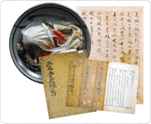|
|
|
|
|

| Home < The food culture of Andong
< Cookbooks of Andong |
|
 |
 |
| |

This book is the first cookbook written by a woman
in Asia. It is written by Ms. Jang whose hometown is
Andong, kept in her son(Lee Huiil)'s house, and donated
to the library of Gyeongbuk university in 1958. There
is the handwritten title "Eumsikdimibang"
at the beginning of the chapter. It contains many arts
of cooking. The prominent feature of this book is the
style of handwriting. The style shows that the writer
made this book with wholeheartedness and earnestness.
This book gives detailed knowledge of making traditional
food and the cooking processes involved. Moreover, it
classifies 146 sorts of food systematically, covering
15 kinds of traditional bread, 12 kinds of oil-and-honey
pastry, 46 kinds of fish and meat dishes, 19 kinds of
vegetable dishes, 51 sorts of alcoholic liquors, 3 kinds
of vinegar. On the last page, she made a request to
women who read the book.
|

|
 |
| |
 This
is the first cookbook written in Chinese characters by
Kim Su, born in Ocheon-dong, Yean, Andong. Suunjapbang
presents many different kinds of liquors. Before this
book was issued, there were many cookbooks imported from
China such as Jeminyosul(issued around 540), Nongsangjipyo(issued
in 1273), and Sangeosayo(published in 1360). Concrete
evidence has been found that Nongsangjipyo came to Korea,
however, no such record of Jeminyosul coming to Korea
has been found in spite of the fact that it is presumed
that the book was current. It is difficult, then, to conclude
that Suunjapbang borrowed the knowledge about liquors
from Jeminyosul. From the fact that in Goryeodogyeong,
there is a record that the people of Goryeo make liquors
from nonglutinous malted rice, and the envoy of the Song
dynasty recognized the difference between the Korean brewing
style and the Chinese one, it seems that Suunjapbang describes
liquors made in a Korean brewing way in spite of the fact
that it has many kinds of liquors which are referred to
many times in Chinese cookbooks. This
is the first cookbook written in Chinese characters by
Kim Su, born in Ocheon-dong, Yean, Andong. Suunjapbang
presents many different kinds of liquors. Before this
book was issued, there were many cookbooks imported from
China such as Jeminyosul(issued around 540), Nongsangjipyo(issued
in 1273), and Sangeosayo(published in 1360). Concrete
evidence has been found that Nongsangjipyo came to Korea,
however, no such record of Jeminyosul coming to Korea
has been found in spite of the fact that it is presumed
that the book was current. It is difficult, then, to conclude
that Suunjapbang borrowed the knowledge about liquors
from Jeminyosul. From the fact that in Goryeodogyeong,
there is a record that the people of Goryeo make liquors
from nonglutinous malted rice, and the envoy of the Song
dynasty recognized the difference between the Korean brewing
style and the Chinese one, it seems that Suunjapbang describes
liquors made in a Korean brewing way in spite of the fact
that it has many kinds of liquors which are referred to
many times in Chinese cookbooks.
|
 |
| |
This cookbook, found in 1987, belongs
to Kim Siu of the uiseong 'Kim' clan. The size of it is
40*2cm. It contains 11 leaves. The first half of the book
is clear and legible, however, the second half part is
unreadable because of tiny letters and scribbled writing
and damage. It contains 56 kinds of recipes including
44 methods of brewing, 2 methods of producing malted rice,
2 techniques of making soy sauce, 6 recipes of cooking
traditional confectionery, and two techniques for cooking
side dishes. It also comprises the days forbidden to brew
and make soy sauce. The second half includes the method
of making medicines and how to take good care of clothes
and dyed goods. Onjubeop records 14 kinds of liquors such
as Nokpaju, Jeonghyanggeukryeolju, Cheongmyeongju, Gamjeomju,
Hahyangju, Jeonghyangju, Seokhyangju, Gugaju, Cheonmyeongbulbyeonju,
Hwanggeumju, Sogukju, Yeolju, Sinbangju, Ohoju. There
are 9 kinds of medicinal spirits including Jihwangju,
Cheonmundongju, Ogapiju, Sojaju, Gugijaju, Changchulju,
Anmyeongju, Baekjaju, Nokmiju, and special medicinal spirits
like Samhaeju and Seowangmoyuokgyeonhyangju. It also contains
4 sorts of strong liquors such as Ihwaju, Sajeolju, Bangsangju,
Samiju and various methods of brewing, the method of a
sweet drink prepared with rice and malt including Hwagukbeop
and Jogukbeop. Furthermore, the book carries the technique
of making soy sauce such as Jeupjangbeop and Japjangbeop.
Moreover, there are techniques for making traditional
confectionery such as Yeonyakbeop, Yakgwabeop, Bingsagwa,
Gangjeong, Bamdasik, Duteopdanja and side dishes like
Yeolgujitang. |
| |
|
|
|
|